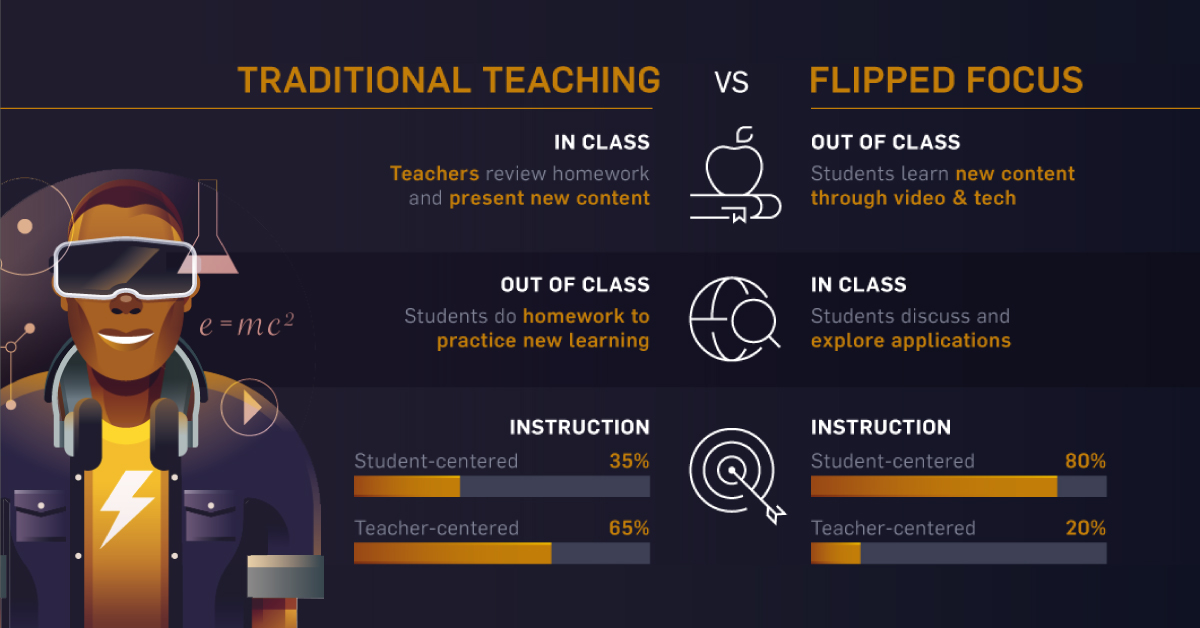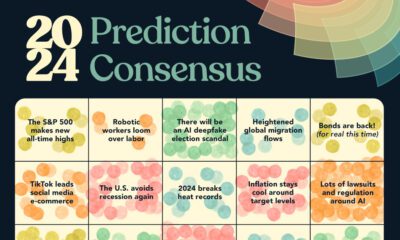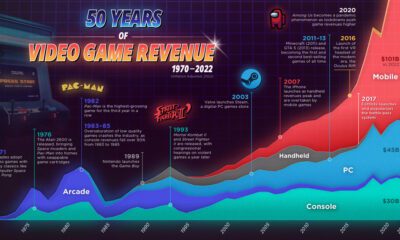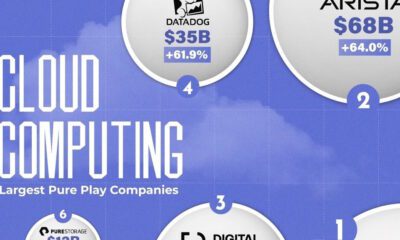Technology
How Technology is Shaping the Future of Education
Technology has transformed almost every aspect of our lives, and now it seems that education systems around the world are due for an update.
Educators are tapping into the digital revolution and adopting new technologies to help students reach their full potential, but can they adapt quickly enough to prepare children for the changing future of work?
The Growing Role of Tech in Classrooms
Today’s infographic from Best Education Degrees explores the different ways technology is transforming classrooms, and disrupting education as we know it.

The Next Generation
Although some might view technology as pervasive, for younger generations, it is ever-present.
Children and young adults make up one-third of all internet users, so it’s no surprise that they are more hyper-connected and digitally savvy than their parents.
The combination of evolving educational needs for children and a more uncertain future of work means that updating what children learn, and how they learn it, has become a crucial issue for schools and colleges—but what should be prioritized?
Classrooms 2.0
In a survey of 1,400 educators, the majority of them say they believe that classrooms of the future will be centered around self-paced and personalized learning.
This student-centric approach would allow children to choose their own pace and learning objectives based on individual interests—all of which could be guided by artificial intelligence, chatbots, and video-based learning.
Artificial Intelligence
Artificial intelligence in education typically focuses on identifying what a student does or doesn’t know, and then subsequently developing a personalized curricula for each student.
The AI-powered language learning platform Duolingo is one of the most downloaded education apps globally, with more than 50 million installs in 2018. The platform single-handedly challenges the notion of traditional learning, with a study showing that spending just 34 hours on the app equates to an entire university semester of language education.
AI-driven applications in education are still in their infancy, but Duolingo’s success demonstrates the growth potential in the sector. In fact, the nascent market for AI in education is expected to reach $6 billion by the year 2025. Over half of this will come from China and the U.S., with China leading globally.
Chatbots
Chatbots are also quickly becoming a fundamental tool in next generation education. Designed to simplify the interaction between student and computer, chatbots provide a wide range of benefits, including:
- Spaced interval learning: Uses algorithms and repetition to optimize memorization
- Immediate feedback: Papers can be graded with 92% accuracy and in a faster time than teachers
- Self-paced learning: Tracks a student’s performance and guides them based on their individual needs
This innovative technology is arming educators with new strategies for more engaged learning, whilst simultaneously reducing their workload.
Video Learning
Although video-based learning may not necessarily be considered as innovative as artificial intelligence or chatbots, 98% of educators view it as a vital component in personalized learning experiences. Most institutions report incorporating video into their curriculums in some way, but even higher demand for video-based learning may come from students in the near future.
This is due to the fact that video learning increases student satisfaction by 91%, and student achievements by 82%, which could be why educators are increasingly using video for tasks like:
- Providing material for student assignments
- Giving feedback on assignments
- Flipped instruction (blended learning) exercises
A flipped classroom overturns conventional learning by focusing on practical content that is delivered online and often outside the classroom.
The Battle Between Traditional and Tech
Flipping classrooms is a trend that has gained momentum in recent years—and may be considered to be a radical change in how students absorb information. The relatively new model also eliminates homework, by empowering students to work collaboratively on their tasks during class time.
Although new models of learning are disrupting the status quo of traditional learning, could the increasing amount of time children spend in front of screens be detrimental?
Research has shown that children are more likely to absorb information from books rather than screens. There has also been an evident increase in low-tech or tech-free schools that believe that human interaction is paramount when it comes to keeping children engaged and excited to learn.
Creating First-Class Humans
Although we may not be in the era of iTeachers just yet, the benefits of technology as teaching aids are undeniable. However, what is more important is that these aids are used in tandem with developmental and educational psychology—ultimately keeping students rather than technology at the core of education.
The future will be about pairing the artificial intelligence of computers with the cognitive, social and emotional capabilities of humans, so that we educate first-class humans, not second-class robots”
—OECD, Trends Shaping Education report
After all, how children develop these skills is perhaps less important than their ability to navigate change, as that is the only thing that will remain constant.
Technology
Ranked: Semiconductor Companies by Industry Revenue Share
Nvidia is coming for Intel’s crown. Samsung is losing ground. AI is transforming the space. We break down revenue for semiconductor companies.
Semiconductor Companies by Industry Revenue Share
This was originally posted on our Voronoi app. Download the app for free on Apple or Android and discover incredible data-driven charts from a variety of trusted sources.
Did you know that some computer chips are now retailing for the price of a new BMW?
As computers invade nearly every sphere of life, so too have the chips that power them, raising the revenues of the businesses dedicated to designing them.
But how did various chipmakers measure against each other last year?
We rank the biggest semiconductor companies by their percentage share of the industry’s revenues in 2023, using data from Omdia research.
Which Chip Company Made the Most Money in 2023?
Market leader and industry-defining veteran Intel still holds the crown for the most revenue in the sector, crossing $50 billion in 2023, or 10% of the broader industry’s topline.
All is not well at Intel, however, with the company’s stock price down over 20% year-to-date after it revealed billion-dollar losses in its foundry business.
| Rank | Company | 2023 Revenue | % of Industry Revenue |
|---|---|---|---|
| 1 | Intel | $51B | 9.4% |
| 2 | NVIDIA | $49B | 9.0% |
| 3 | Samsung Electronics | $44B | 8.1% |
| 4 | Qualcomm | $31B | 5.7% |
| 5 | Broadcom | $28B | 5.2% |
| 6 | SK Hynix | $24B | 4.4% |
| 7 | AMD | $22B | 4.1% |
| 8 | Apple | $19B | 3.4% |
| 9 | Infineon Tech | $17B | 3.2% |
| 10 | STMicroelectronics | $17B | 3.2% |
| 11 | Texas Instruments | $17B | 3.1% |
| 12 | Micron Technology | $16B | 2.9% |
| 13 | MediaTek | $14B | 2.6% |
| 14 | NXP | $13B | 2.4% |
| 15 | Analog Devices | $12B | 2.2% |
| 16 | Renesas Electronics Corporation | $11B | 1.9% |
| 17 | Sony Semiconductor Solutions Corporation | $10B | 1.9% |
| 18 | Microchip Technology | $8B | 1.5% |
| 19 | Onsemi | $8B | 1.4% |
| 20 | KIOXIA Corporation | $7B | 1.3% |
| N/A | Others | $126B | 23.2% |
| N/A | Total | $545B | 100% |
Note: Figures are rounded. Totals and percentages may not sum to 100.
Meanwhile, Nvidia is very close to overtaking Intel, after declaring $49 billion of topline revenue for 2023. This is more than double its 2022 revenue ($21 billion), increasing its share of industry revenues to 9%.
Nvidia’s meteoric rise has gotten a huge thumbs-up from investors. It became a trillion dollar stock last year, and broke the single-day gain record for market capitalization this year.
Other chipmakers haven’t been as successful. Out of the top 20 semiconductor companies by revenue, 12 did not match their 2022 revenues, including big names like Intel, Samsung, and AMD.
The Many Different Types of Chipmakers
All of these companies may belong to the same industry, but they don’t focus on the same niche.
According to Investopedia, there are four major types of chips, depending on their functionality: microprocessors, memory chips, standard chips, and complex systems on a chip.
Nvidia’s core business was once GPUs for computers (graphics processing units), but in recent years this has drastically shifted towards microprocessors for analytics and AI.
These specialized chips seem to be where the majority of growth is occurring within the sector. For example, companies that are largely in the memory segment—Samsung, SK Hynix, and Micron Technology—saw peak revenues in the mid-2010s.
-

 Maps2 weeks ago
Maps2 weeks agoMapped: Average Wages Across Europe
-

 Money1 week ago
Money1 week agoWhich States Have the Highest Minimum Wage in America?
-

 Real Estate1 week ago
Real Estate1 week agoRanked: The Most Valuable Housing Markets in America
-

 Markets1 week ago
Markets1 week agoCharted: Big Four Market Share by S&P 500 Audits
-

 AI1 week ago
AI1 week agoThe Stock Performance of U.S. Chipmakers So Far in 2024
-

 Automotive1 week ago
Automotive1 week agoAlmost Every EV Stock is Down After Q1 2024
-

 Money2 weeks ago
Money2 weeks agoWhere Does One U.S. Tax Dollar Go?
-

 Green2 weeks ago
Green2 weeks agoRanked: Top Countries by Total Forest Loss Since 2001














